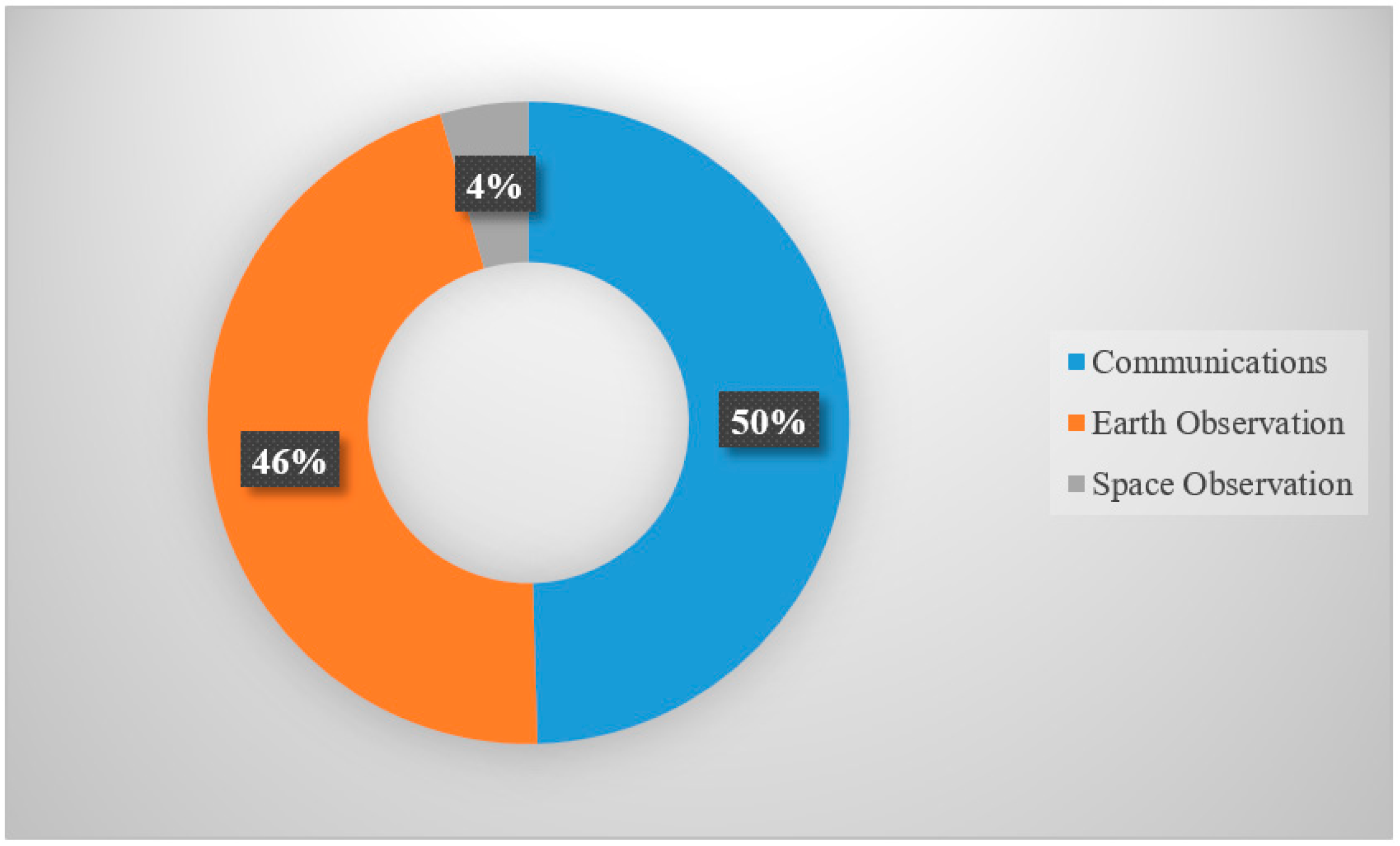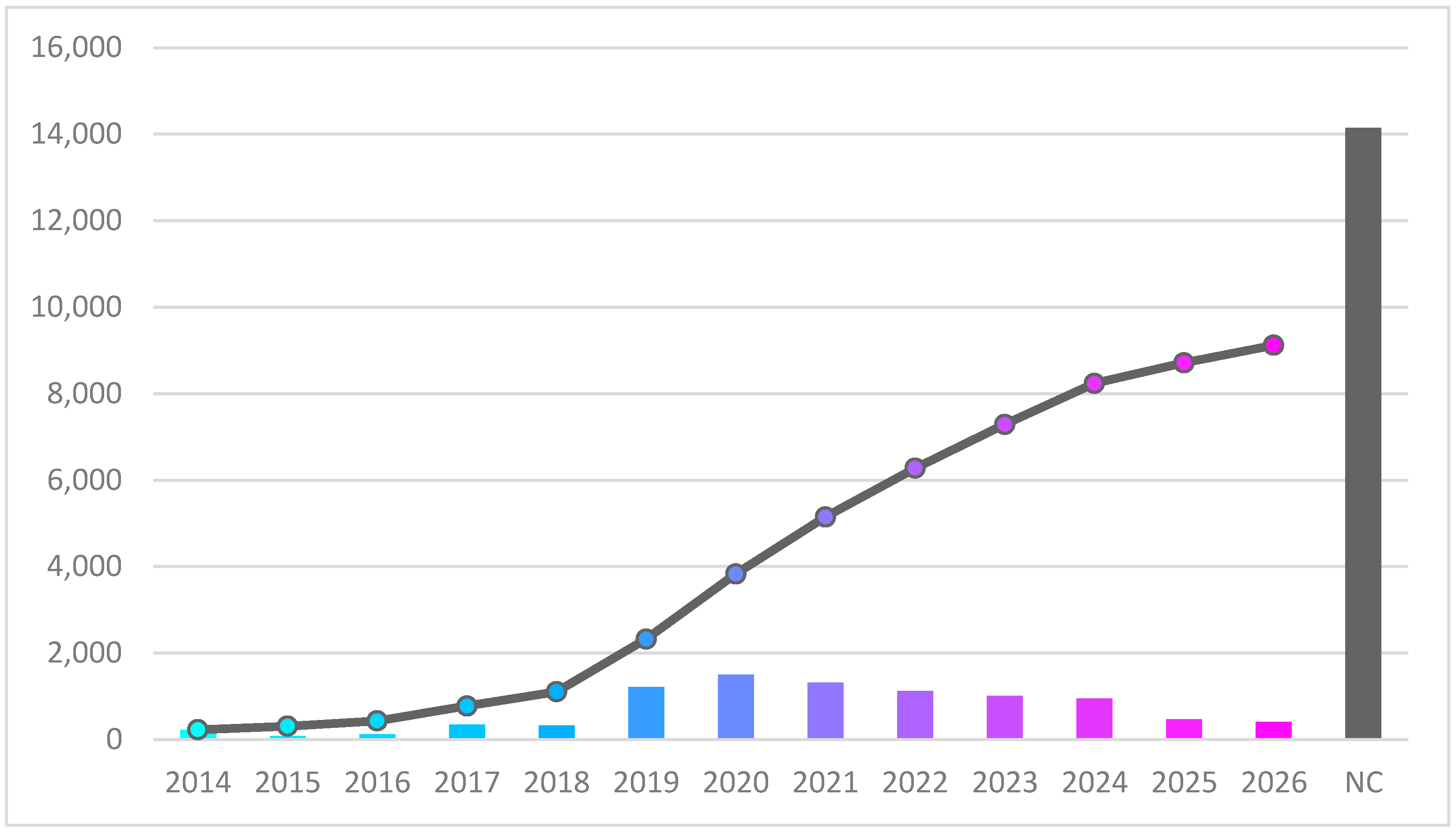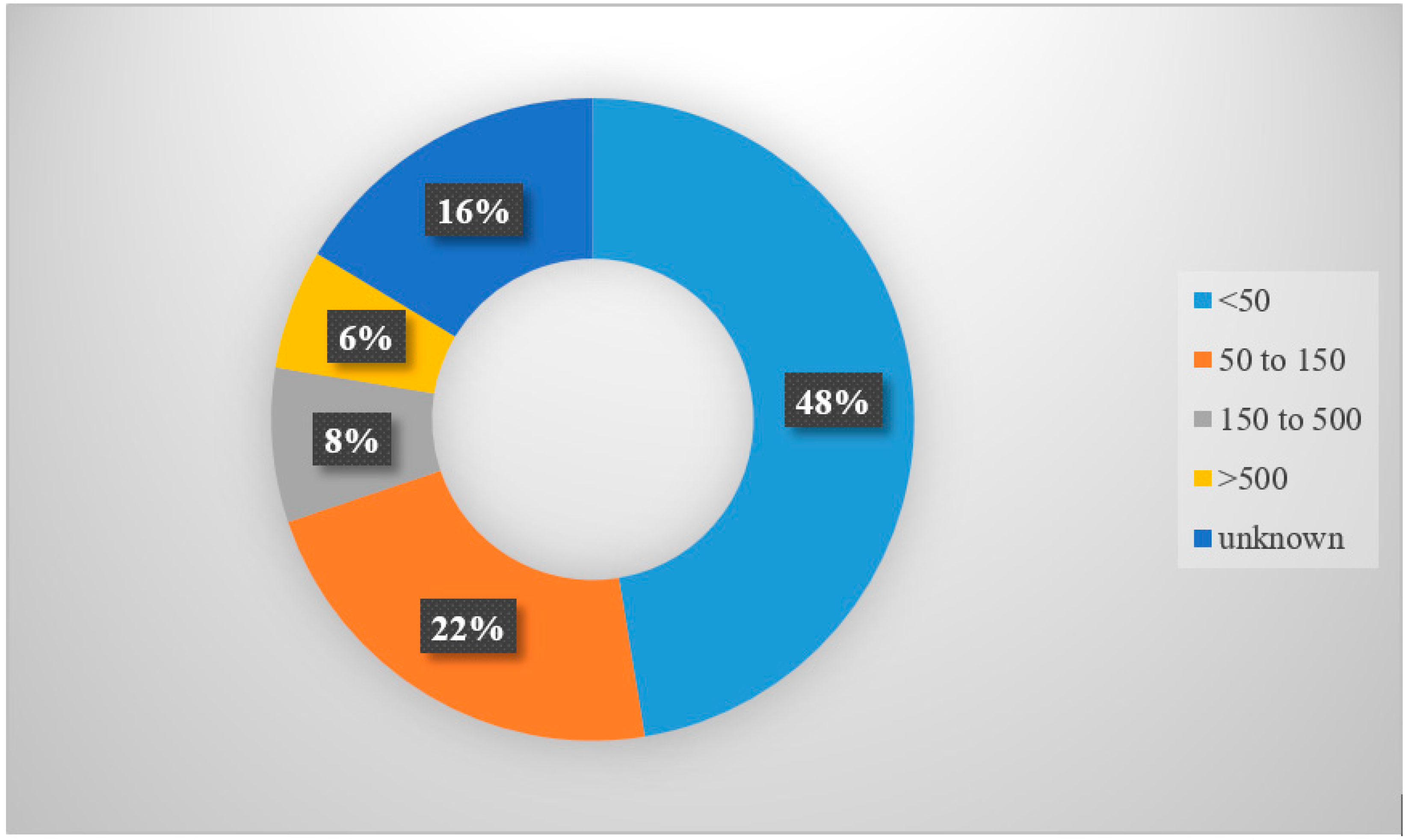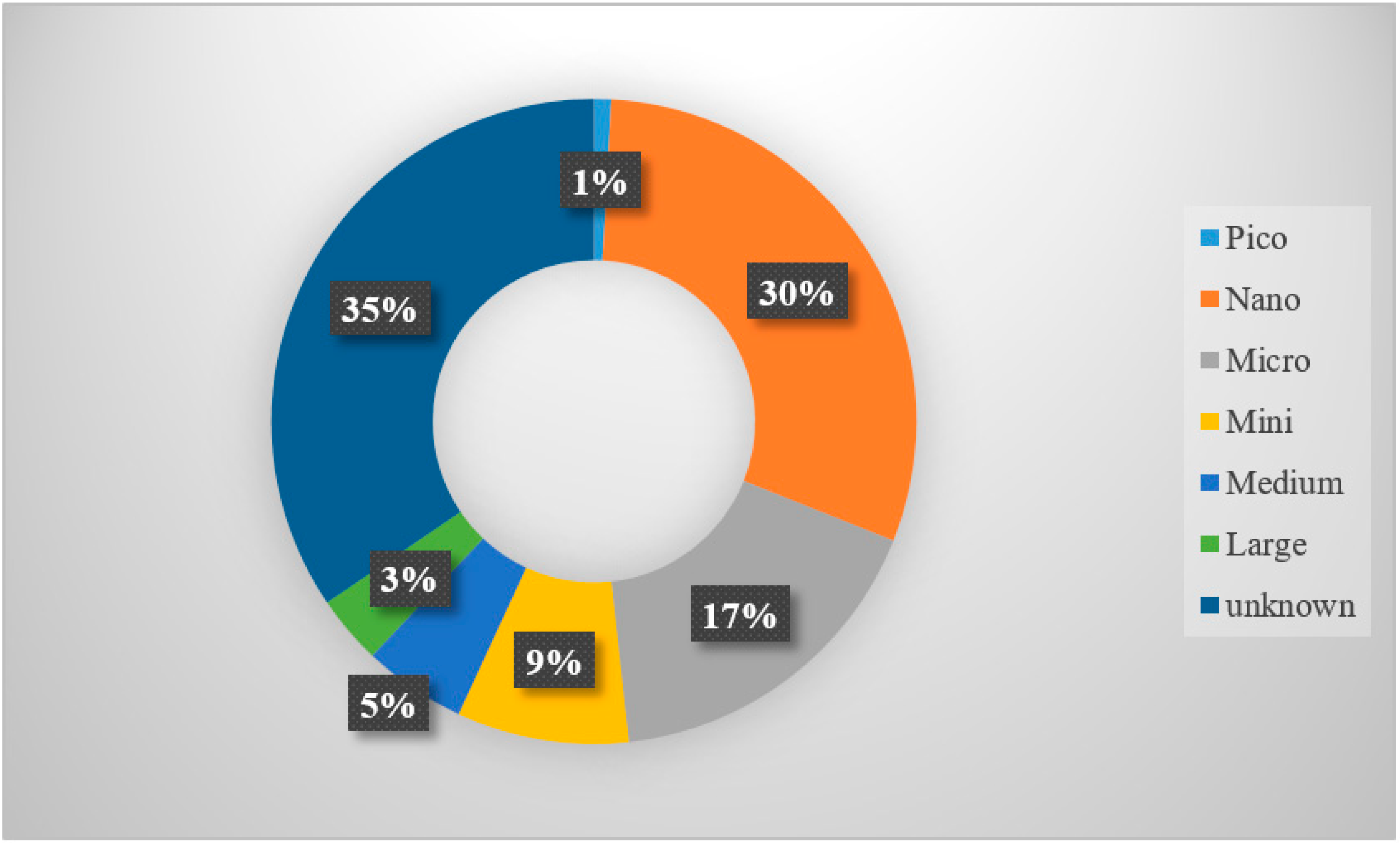The New Space Economy encourages constellations of satellites that are being proposed in large numbers by private companies. They will provide communication, enable global monitoring of Earth, and enhance space observation. Mostly enabled by technology miniaturization, satellite constellations require a coordinated effort to face the technological limits in spacecraft operations and space traffic. In this Topic Review, we provide a survey of the upcoming satellite constellations and an overview of future challenges to be faced.
- large constellations
- operations
- space traffic
1. Introduction
The idea of a constellation of satellites appeared in the market about twenty years ago with Iridium and Globalstar as pioneering examples. They offered worldwide communication links competing with the terrestrial cellular network, having, however, limited success due to service costs mainly [
,
]. We can now say that at that time the business model was not sustainable due to the small market and high initial and maintenance costs.
Access to space is now broadening thanks to technology miniaturization and design experience. With a tremendous forecasted increase in the launch rate for small satellites (from pico-sized to mini-sized) [
], constellations are getting attention again from sustainable businesses [
].
Constellations have their greatest potential in the communication field. The upcoming era of the Internet-Of-Things requires the communication infrastructure to handle huge amounts of data and to guarantee service in any geographical position. Constellations, however, also have great potential in weather science, safety/security and disaster monitoring [
].
In the rapidly emerging business of satellite constellations, it is important to track and update the information about players and trends to guide future developments.
2. Satellite Constellation Players
There have been few attempts to propose large satellite constellations for commercial purposes in the past few decades (from ca. the late-90s to 2015). Among them were the companies ViaSat, Boeing, Samsung, Yaliny [
], Globalstar [
] and Iridium [
]. In all cases, the target application was in the communication field, aimed at providing global connectivity with different strategies: medium Earth orbit (MEO) or low Earth orbit (LEO) constellations, and large or small numbers of satellites. All of them have been delayed [
], restyled [
] or have failed [
]. These proposals are included anyway in the upcoming statistical analysis, for possibly being part of future or current space traffic. Non-commercial constellations for Global Navigation Satellite System (GNSS) purposes, namely, the GPS, GLONASS, Galileo and BeiDou are included as well. Constellations in GEO orbit, such as IRNSS, are instead left out of the statistics.
In the last few years, the proposals of satellite constellations have experienced a tremendous increase with more than one hundred companies trying to succeed in different markets with different approaches. At the time of writing, more than 90 companies or agencies (other than older attempts, some of which are mentioned above) have been found proposing satellite constellations.
The target fields of application can be grouped in three categories: Earth observation (EO) (science or business oriented), space observation (SO) and communications (Comm). Figure 1 clearly suggests that applications in EO (such as weather, disaster and alert monitoring) and communications (Internet-of-Things, machine-to-machine applications) are the driving sectors for the constellations being proposed.
Figure 1.
Percentages of proposed constellations in different market fields.
The distribution of some constellation characteristics, such as the number and size of satellite platforms and expected time to completion, is also of interest.
depicts the trend of the number of proposed constellation satellites expected to be in orbit in the next years. Note that the number of satellites and the expected year of completion for a constellation are not always available, probably due to a lack of confidence from the companies. Those companies have been assigned to the category “NC” in the figure. Additional details and references are given in
. Furthermore, in preparing
the assumption of a constant deployment rate was made for each constellation. This assumption is made necessary because of the lack of information on the deployment plans by many companies. Therefore, for each constellation, the difference between the year of the first satellite launch (occurred or planned) and the expected year of completion has been considered as the deployment window. By dividing the number of satellites in the constellation by the deployment window, a constant deployment rate was obtained which was then used to populate
.
Figure 2.
Expected time evolution of in orbit spacecraft due to constellations. Colored histogram bars represent the estimated number of satellites launched yearly (see
in
for details). Black, dotted line represents cumulative sum. Not-classified (NC) stands for companies that have not published expected time-to-service.
Although some constellations still have unpublished years of completion, many are expected to be in orbit by 2022 with a peak in 2020. This reflects the rapid development of the market and the high competitiveness which stresses the shortening of the time-to-market. A clear outlier is the Starlink constellation from SpaceX, with a 4425-element constellation dominating the columns of the years 2019 to 2024—the year in which it is expected to be completed. This delay in the time-to-market is probably due to the large amount of satellites that are expected to be placed.
Looking at the cumulative sum, the number of satellites in orbit is going to increase more than linearly with about 8000 spacecraft in orbit in 2024 due to constellations only. The resulting volume of traffic opens up a question about whether it is possible to sustain this development or not, under several points of view. For example, the current ground segment infrastructures will probably not be able to monitor and control such a large number of satellites. A major satellite ground service provider such as KSAT is already investing for infrastructure enlargement [
]. At the same time, constellation management shall be enhanced to make an efficient use the new infrastructure. This requires new operational architectures towards higher automation, either onboard or on ground, involving, for instance, artificial intelligence and virtual reality [
,
]. A second concern involves the communication, with the RF spectrum becoming possibly overcrowded and the required data-throughput increasingly larger. Lastly, but probably most importantly, the space traffic and debris issues, which may prevent the safe and successful operation of spacecraft [
].
As far as the size is concerned, the proposed constellations are quite widespread. According to
, roughly half of the constellations are relatively small, containing less than 50 elements. Constellations with numbers of elements between 50 and 150 elements appear to be quite appealing as well, with a 22% share. Larger size slots are instead of particularly low interest. Finally, a considerable 16% features non-declared sizes, as anticipated.
Figure 3.
Constellations by satellite numbers.
Satellite sizes show a clear bias towards micro and nano classes, reflecting the trend towards the miniaturization of satellite platforms in general (
). Although 35% of the constellation projects do not declare size, 30% belong to nano-class and 17% to micro-class. Pico, mini, medium and large classes reflect the minority, with a total share of 18%. This means that constellations are going to be composed of satellites weighting mainly from 1 to 100 kg.
Figure 4.
Constellations by satellite sizes: mass < 1 kg = pico; 1 kg < mass < 10 kg = nano; 10 kg < mass < 100 kg = micro; 100 kg < mass < 500 kg = mini; 500 kg < mass <1000 kg = medium, mass > 1000 kg = large.
3. Challenges
Large constellations will require a paradigm shift with respect to the way space missions are currently handled, with major challenges involving mainly three areas, namely constellation management, communication and space traffic. The level of maturity reached by these three areas is, however, not homogeneous: communication is probably the most matured, where relevant work is being done concerning infrastructure integration and protocol efficiency.
Some significant past experience in constellation management was reviewed in the full article; still, the need for an improved level of automation is clear. In this respect, artificial intelligence seems to be a valuable option, together with infrastructure sharing for rapid development and commercial viability.
On the other hand, space traffic management is mostly unprepared, with significant developments only in terms of debris countermeasures. Some extensions of the air traffic regulation are expected in the years to come to mitigate the current free-space policy covered by the Outer Space Treaty.
Although many technical challenges are still being addressed, the amount of work that has been analyzed during this review suggests good chances of success for large constellation missions.
References
- McIntyre, D.A. The 10 Biggest Tech Failures of the Last Decade—Failure to Launch Iridium. 14 May 2009. Available online: http://content.time.com/time/specials/packages/article/0,28804,1898610_1898625_1898640,00.html (accessed on 28 June 2019).
- Glasner, J. Globalstar: Broke But Not Out. 14 November 2001. Available online: https://www.wired.com/2001/11/globalstar-broke-but-not-out/ (accessed on 20 July 2019).
- Williams, C.; Doncaster, B.; Shulman, J. 2018 Nano/Microsatellite Market Forecast, 8th ed.; SpaceWorks Enterprises Inc.: Atlanta, GA, USA, 2018. [Google Scholar]
- Lal, B.; de la Rosa, E.B.; Behrens, J.; Corbin, B.; Green, E.K.; Picard, A.A.J.; Balakrishnan, A. Global Trends in Small Satellites; IDA Science and Technology Policy Institute: Alexandria, VA, USA, 2017. [Google Scholar]
- Sandaua, R.; Brieß, K.; D’Errico, M. Small satellites for global coverage: Potential and limits. ISPRS J. Photogramm. Remote Sens. 2010, 65, 492–504. [Google Scholar] [CrossRef]
- Panga, W.J.; Bo, B.; Meng, X.; Yu, X.Z.; Guo, J.; Zhou, J. Boom of the CubeSat: A Statistic Survey of CubeSats Launch in 2003–2015. In Proceedings of the 67th International Astronautical Congress (IAC), Guadalajara, Mexico, 26–30 September 2016. [Google Scholar]
- Muelhaupt, T.J.; Sorge, M.E.; Morin, J.; Wilson, R.S. Space traffic management in the new space era. J. Space Saf. Eng. 2019, 85, 51–60. [Google Scholar] [CrossRef]
- Selva, D.; Golkar, A.; Korobova, O.; Cruz, I.L.; Collopy, P.; de Weck, O.L. Distributed Earth Satellite Systems: What Is Needed to Move Forward? J. Aerosp. Inf. Syst. 2017, 14, 412–438. [Google Scholar] [CrossRef]
- Henry, C. LEO and MEO Broadband Constellations Mega Source of Consternation. 13 March 2018. Available online: https://spacenews.com/divining-what-the-stars-hold-in-store-for-broadband-megaconstellations/ (accessed on 20 July 2019).
- Globalstar Completes 48-Satellite Constellation. 23 November 1999. Available online: https://www.wirelessnetworksonline.com/doc/globalstar-completes-48-satellite-constellati-0001 (accessed on 28 June 2019).
- Flarewell. 2019. Available online: https://www.iridium.com/flarewell/ (accessed on 20 July 2019).
- Henry, C. Boeing Constellation Stalled, SpaceX Constellation Progressing. 27 June 2018. Available online: https://spacenews.com/boeing-constellation-stalled-spacex-constellation-progressing/ (accessed on 20 July 2019).
- Henry, C. Viasat Shrinks MEO Constellation Plans. 5 November 2018. Available online: https://spacenews.com/viasat-shrinks-meo-constellation-plans/ (accessed on 28 July 2019).
- Lim, J.; Klein, R.; Thatcher, J. GOOD TECHNOLOGY, BAD MANAGEMENT: A CASE STUDY OF THE SATELLITE PHONE INDUSTRY. J. Inf. Technol. Manag. 2005, 16, 48–55. [Google Scholar]
- Eilerten, B.; Krynitz, M.; Olafsson, K. NewSpace—Forcing a rethink of ground networks. In Proceedings of the 14th International Conference on Space Operations, Daejeon, Korea, 16−20 May 2016; p. 2599. [Google Scholar]
- Monteverde, J.; Bullock, M.; Schulz, K.-J. Operations Innovation. In Proceedings of the Industry Workshop, ESA-ESOC, Darmstadt, Germany, 17−18 January 2019; Available online: https://atpi.eventsair.com/QuickEventWebsitePortal/19c10---industry-workshop/website/ExtraContent/ContentPage?page=4 (accessed on 29 July 2019).
- Babrinsky, N. Mission Operations Ground Segments Space Safety. In Proceedings of the Industry Workshop, ESA-ESOC, Darmstadt, Germany, 17−18 January 2019; Available online: https://atpi.eventsair.com/QuickEventWebsitePortal/19c10---industry-workshop/website/ExtraContent/ContentPage?page=4 (accessed on 29 July 2019).




